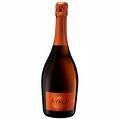Producer of the Year: My selection for 2008 Winery of the  Year is Champagne Ayala, based in Aÿ, a village in the Champagne region of France. A close runner-up is the exceptional Champagne Henriot, whose 1998 Brut Souverain colleague Robert Whitley was recently swooning over in his blog on Champagne. I chose Ayala because its improvement has been so dramatic in this past year.
Year is Champagne Ayala, based in Aÿ, a village in the Champagne region of France. A close runner-up is the exceptional Champagne Henriot, whose 1998 Brut Souverain colleague Robert Whitley was recently swooning over in his blog on Champagne. I chose Ayala because its improvement has been so dramatic in this past year.
It might seem strange that I am selecting a Champagne house that has been around since 1860, but this is not the same Champagne firm that I remember from a couple of decades ago. That Ayala — owned at the time by the same family that is the proprietor of the very respectable classified Bordeaux growth, Château La Lagune in the Médoc — was foundering, a victim of neglect, caused by absentee ownership. I remember visiting Ayala in the mid-90s and being disappointed, mainly because no one seemed to be looking after this once-noble house, a founding member of the Syndicate de Grands Marques (an organization of 18 of the most prestigious firms in Champagne, now disbanded).
Shortly after my visit, Ayala disappeared from the U.S. market. Years went by, and we all forgot about the house. When I visited Champagne Bollinger in 2006, Ghislain Montgolfier, managing director of Bollinger, told me that Bollinger, also in Aÿ, had purchased Ayala. I was surprised, but it turned out to be the best thing that ever happened to Ayala. Just as Champagne Deutz greatly improved after Louis Roederer bought a controlling interest in it a decade ago, Ayala has turned around and is now in top form. This year, Ayala was re-launched on the U.S. market with a series of eight stunning Champagnes. I tasted Ayala’s entire line, except its demi-sec, earlier this year, and was amazed by its general excellence. Ayala’s style is rather the opposite of Bollinger — which is known for its powerful, full-bodied Champagnes. Ayala stresses finesse and elegance, with a strong emphasis on Chardonnay, somewhat reminiscent of a neighboring Champagne firm, Billecart-Salmon. But Ayala’s prices are much more reasonable than the rather expensive (these days) Billecart-Salmon: Ayala’s Brut non-vintage, Brut Majeur, retails for about $38, and its top-of-the-line prestige cuvee, Cuvée Perle d’Ayala, costs about $125.
What I really like about Ayala’s style is the dryness of its Champagnes: except for Rich Majeur, its demi-sec, all Ayala Champagnes have either very low dosage (added sugar/wine blend) or no dosage at all! Ayala is now producing three no-dosage Champagnes: a NV Zéro Dosage Brut Majeur (in addition to its low-dosage NV Brut); a super Cuvée Rosé Nature; and with the 2002 vintage, its prestige wine, Cuvée Perle d’Ayala, is also a Nature (French synonym for zero dosage). Ayala’s three other low-dosage Champagnes are its NV Rosé Majeur, its very good 1999 Vintage Brut, and its excellent 2000 Blanc de Blancs. (Importer: Cognac One, New York).
Wine of the Year: Ayala Cuvée Rosé Nature. Many rosé  Champagnes are a bit too fruity for me. I love rosés when they’re really dry, such as Krug’s and Bollinger’s. Unfortunately, the exceptional Krug Rosé is very expensive (about $350) and Bollinger’s Vintage ‘La Grande Année’ Rosé is about $200. This is the reason that I was delighted when Ayala introduced what might be the only zero-dosage rosé Champagne, at least on the U.S. market, its NV Cuvée Rosé Nature, which retails for about $85 to $90. It’s pale salmon pink in color, totally dry, and totally delicious, with complex aromas and flavors reminiscent of wild strawberries. This Champagne stopped me in my tracks. The only reasonable response to drinking it is, ‘I’ll have another glass, please.’ (Importer: Cognac One, New York).
Champagnes are a bit too fruity for me. I love rosés when they’re really dry, such as Krug’s and Bollinger’s. Unfortunately, the exceptional Krug Rosé is very expensive (about $350) and Bollinger’s Vintage ‘La Grande Année’ Rosé is about $200. This is the reason that I was delighted when Ayala introduced what might be the only zero-dosage rosé Champagne, at least on the U.S. market, its NV Cuvée Rosé Nature, which retails for about $85 to $90. It’s pale salmon pink in color, totally dry, and totally delicious, with complex aromas and flavors reminiscent of wild strawberries. This Champagne stopped me in my tracks. The only reasonable response to drinking it is, ‘I’ll have another glass, please.’ (Importer: Cognac One, New York).
5
